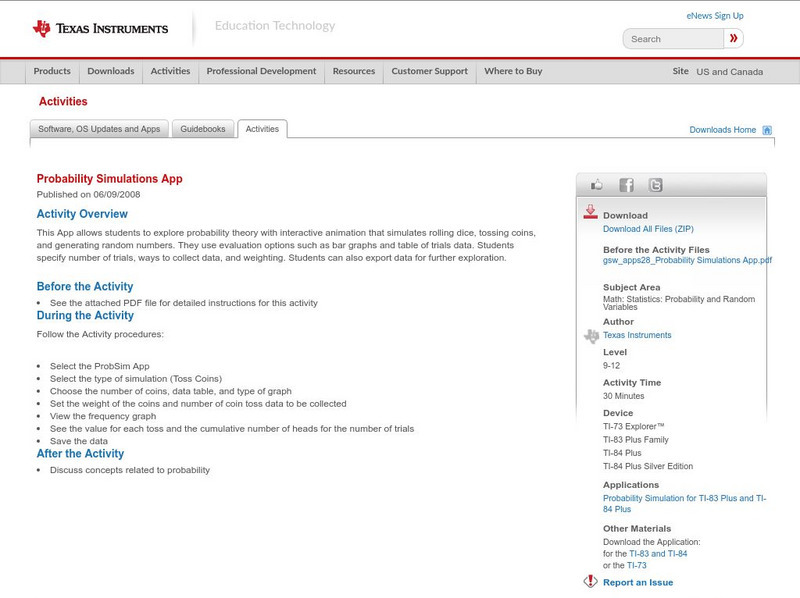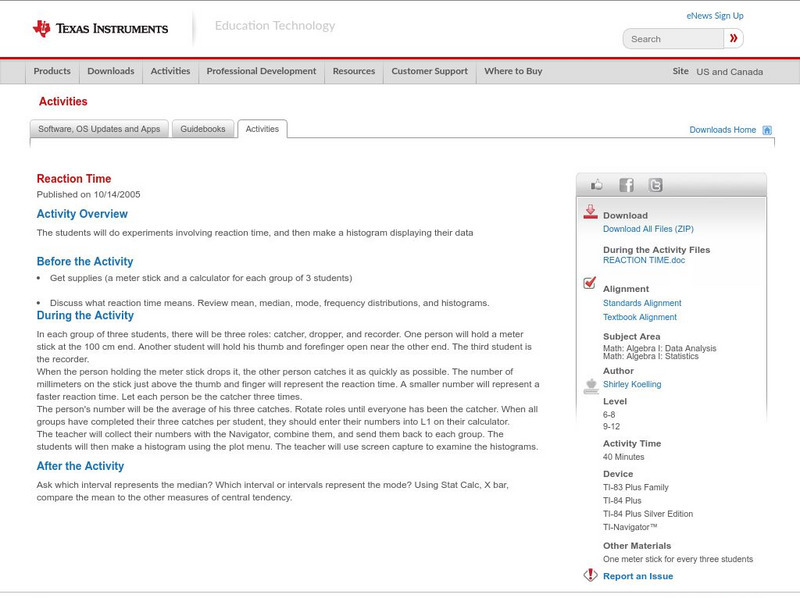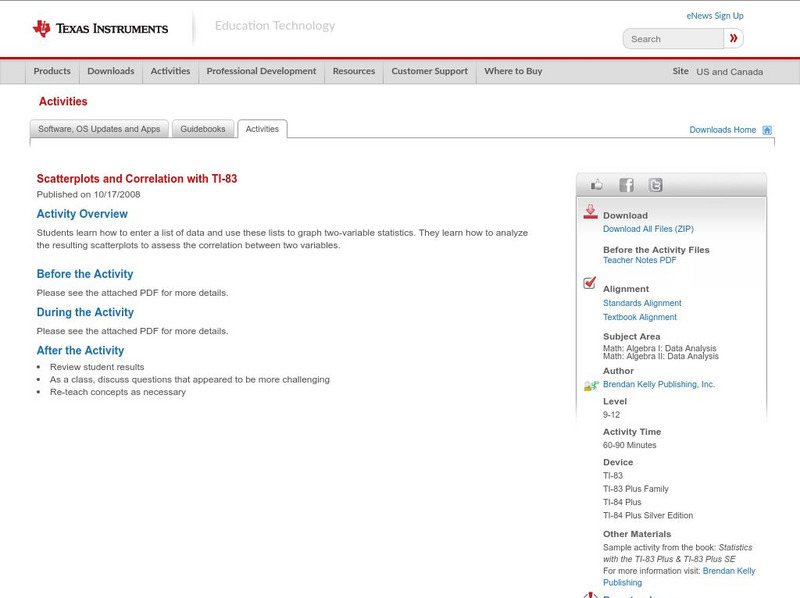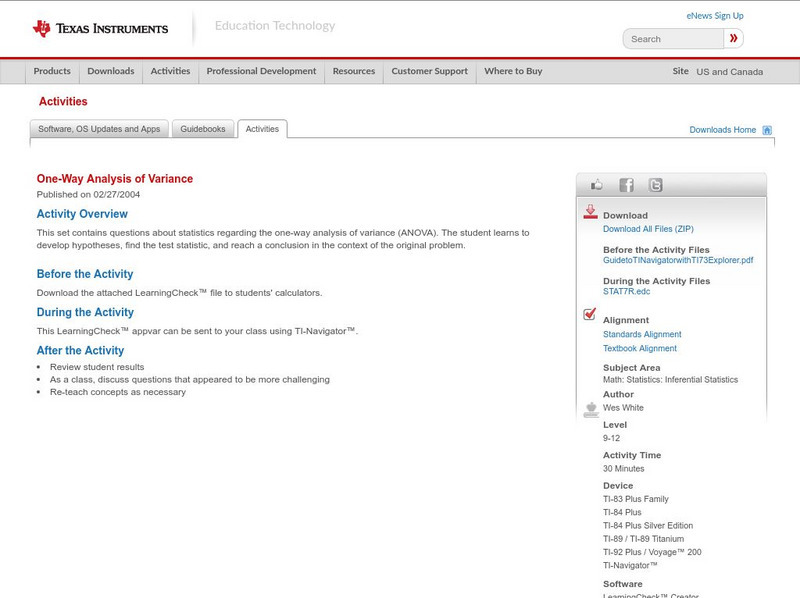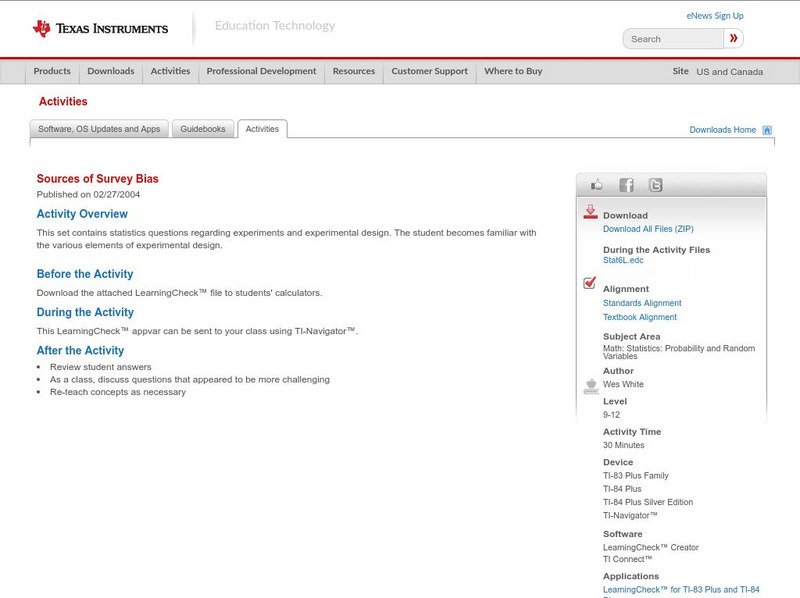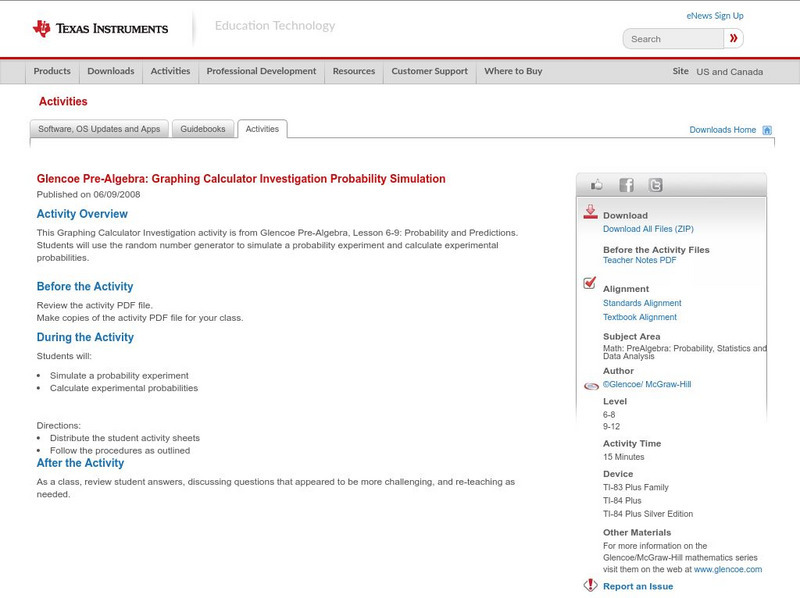Texas Instruments
Texas Instruments: A Simulation
In this activity, students use the CellSheet Application to simulate a probability event. This activity simulates an experiment performing a survey. Students can see that the results of a random survey can vary widely if a small sample...
Texas Instruments
Texas Instruments: Probability Simulations App
This App allows students to explore probability theory with interactive animation that simulates rolling dice, tossing coins, and generating random numbers. They use evaluation options such as bar graphs and table of trials data....
Texas Instruments
Texas Instruments: Reaction Time
The students will do experiments involving reaction time, and then make a histogram displaying their data.
Texas Instruments
Texas Instruments: Comparing Distributions of Univariate Data
Students compare univariate data distributions using statistical concepts like box plots, stem plots, and histograms.
Texas Instruments
Texas Instruments: Numb3 Rs: "Take Out" Outliers
Based off of the hit television show NUMB3RS, this lesson has students create box-and-whisker plots for given data, and then determine which (if any) data points are outliers. Students determine outliers through two methods in this...
Texas Instruments
Texas Instruments: Scatterplots and Correlation With Ti 83
Students learn how to enter a list of data and use these lists to graph two-variable statistics. They learn how to analyze the resulting scatterplots to assess the correlation between two variables.
Texas Instruments
Texas Instruments: One Way Analysis of Variance
This set contains questions about statistics regarding the one-way analysis of variance (ANOVA). The student learns to develop hypotheses, find the test statistic, and reach a conclusion in the context of the original problem.
Texas Instruments
Texas Instruments: Summarizing Distributions of Univariate Data
Students understand statistical concepts like center of data and the amount of data variation from the center. They calculate the measures of the center of a distribution and the measures of spread for the data collected as a list....
Texas Instruments
Texas Instruments: Law of Large Numbers: Equal Opportunities
In this activity, students can use the Probability Simulation application to roll a fair die and explore the Law of Large Numbers. They will conduct probability experiments that involve tossing a fair die, graph the results, compare the...
Texas Instruments
Texas Instruments: Sources of Survey Bias
This set contains statistics questions regarding experiments and experimental design. The student becomes familiar with the various elements of experimental design.
Texas Instruments
Texas Instruments: Distributions and Univariate Data
This set contains statistics questions comparing distributions of univariate data. The student is asked to note the differences between distributions regarding center, shape, spread, and existence of outliers.
Texas Instruments
Texas Instruments: Graphing Calculator Investigation Probability Simulation
Students can use the random number generator to simulate a probability experiment and calculate experimental probabilities.
Texas Instruments
Texas Instruments: Scatterplots and Correlation With Ti 89
Students input data relating the values of one variable associated with values of another and use these data to generate a scatterplot. From the scatterplot, they determine whether there is a correlation between the two variables and...
Palomar Community College District
Palomar College: Behavioral Science Statistics: Frequency Histogram an Example
A step-by-step worked problem demonstrating how to take a set of data and produce a frequency histogram. Hints are provided along the way and the final graph is shown for the user to check.
Mangahigh
Mangahigh: Data: Two Way Tables
This site provides students practice with the concept of two way tables. Students can learn about the topic by completing an interactive tutorial. Students can then take a ten question timed test to practice the skill.
CK-12 Foundation
Ck 12: Earth Science: Observations and Experiments
[Free Registration/Login may be required to access all resource tools.] Using observations and scientific experiments to test hypotheses.
Texas Education Agency
Texas Gateway: Experimental Design
Given investigation scenarios and lab procedures, students will identify independent variables, dependent variables, constants, and control groups.
CK-12 Foundation
Ck 12: Probability: Empirical Probability Grades 9 10
[Free Registration/Login may be required to access all resource tools.] Simulate real-life situations with an experiment and find the experimental probability of a specific event.
Other
Uah: Virtual Labs in Probability and Statistics
This page provides links to various interactive experiments in probability and statistics.
Annenberg Foundation
Annenberg Learner: Against All Odds: Describing Relationships
Video program showing how to use a scatter plot to illustrate relationship between response and explanatory variables, to determine patterns in variables, and to calculate least squares. Real-life examples -- manatee deaths per number of...
Shmoop University
Shmoop: Basic Statistics & Probability: Designing a Study
Presents the steps to follow in designing a study in statistics and explains what makes a good statistical question.
Web Center for Social Research Methods
Research Methods Knowledge Base: Sampling in Research
Site discusses the use of sampling in research. The key statistical terms used in sampling are linked for the user to quickly find definitions. The major concepts of probability and nonprobability are also highlighted.
University of Regina (Canada)
University of Regina: Math Central: Scatter Plots
Three different concepts are examined about scatter plots. Topics featured are collecting data, analyzing scatter plots, and determining a line of "best fit". The activity has an overview, material, procedures, and evaluation techniques.
Texas Instruments
Texas Instruments: Describing Categorical Data
Students analyze the distribution of categorical data. They calculate percents and visually compare the data sets with a bar chart.



